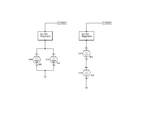nickagian
Member level 4

- Joined
- Mar 19, 2009
- Messages
- 71
- Helped
- 2
- Reputation
- 4
- Reaction score
- 2
- Trophy points
- 1,288
- Location
- Zurich, Switzerland
- Activity points
- 2,001
Hi to all,
I am asking again this common question, because I want to make things clear in my mind. In the attached file you can see the two different configuration that I have in mind for my project. I want to deliver regulated 3.3V to the electronics from battery voltage. One solution is to use two batteries in parallel (actually one battery could do the same job, two are for increasing capacity) and use a step down/step up DC/DC regulator like TPS63001. The second solution is to put two batteries in series and then use a step-down DC/DC regulator. like the TPS62056. My question is which of the two configurations give bigger battery capacity and thus longer autonomy for my circuit.
Assuming that both DC/DC regulator have an effiency of η and that the capacity of all batteries is 1.2Ah. For both configurations, the available energy has the same value: J = η * [(3.6V * 1.2Ah * 2]
Can anybody help me on how to compute the autonomy of a theoretical circuit that has an average current consumption of (let's say) 200uA per hour? Which is the best to achieve bigger lifetime and how can it be justified?
Can anybody help me with this?
Thanks,
Nikos
I am asking again this common question, because I want to make things clear in my mind. In the attached file you can see the two different configuration that I have in mind for my project. I want to deliver regulated 3.3V to the electronics from battery voltage. One solution is to use two batteries in parallel (actually one battery could do the same job, two are for increasing capacity) and use a step down/step up DC/DC regulator like TPS63001. The second solution is to put two batteries in series and then use a step-down DC/DC regulator. like the TPS62056. My question is which of the two configurations give bigger battery capacity and thus longer autonomy for my circuit.
Assuming that both DC/DC regulator have an effiency of η and that the capacity of all batteries is 1.2Ah. For both configurations, the available energy has the same value: J = η * [(3.6V * 1.2Ah * 2]
Can anybody help me on how to compute the autonomy of a theoretical circuit that has an average current consumption of (let's say) 200uA per hour? Which is the best to achieve bigger lifetime and how can it be justified?
Can anybody help me with this?
Thanks,
Nikos
Attachments
Last edited:



